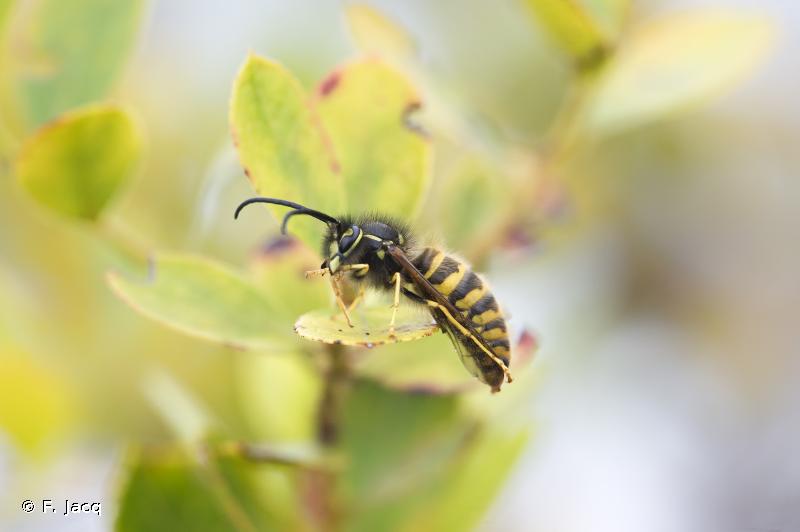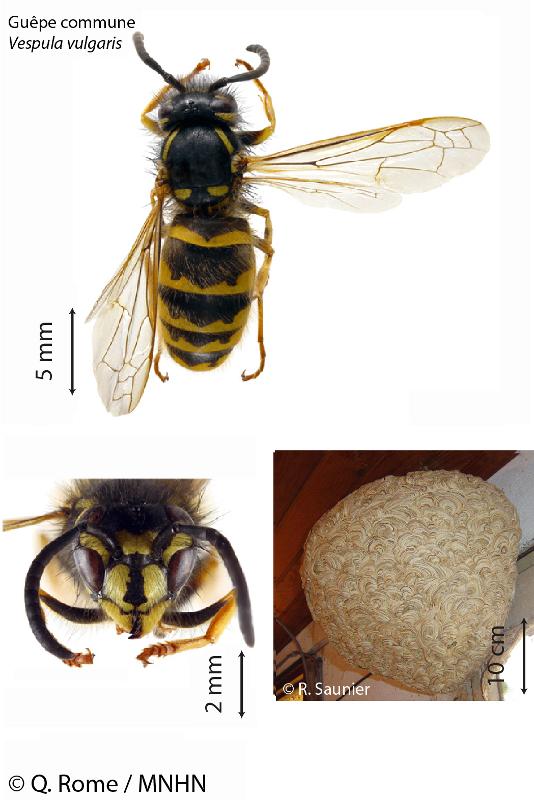
cd_nom

| Author : F. Jacq |
 |
To get the picture, please visit:
Frédéric Jacq
site internet : fred-jacq.org
email : jacq_fred@hotmail.com
Legend: Manu patia, guêpe commune, Vespula vulgaris, guêpe introduite et envahissante, ici sur la crête "Te ara po", au mont Marau à 1480 m d'altitude, sur l'île de Tahiti, archipel de la Société
Any reuse of one or more photographs on this site is subject to an authorization request from the author.
Link to the Code of Intellectual Property (Legifrance)

| Author : Q. Rome |
 |
To get the picture, please visit:
Quentin Rome
Muséum national d'Histoire naturelle
UMR7205 CNRS
Entomologie CP50 - Service Hymenoptera
45 rue Buffon 75005 Paris
courriel : rome@mnhn.fr
Legend: Ouvrière
Despite the Creative Commons license, please inform the author of the use which will be made of his photo

 |
To get the picture, please visit:
Quentin Rome
Muséum national d'Histoire naturelle
UMR7205 CNRS
Entomologie CP50 - Service Hymenoptera
45 rue Buffon 75005 Paris
courriel : rome@mnhn.fr
Despite the Creative Commons license, please inform the author of the use which will be made of his photo
Taille/poids :
Longueur du corps : 11 à 14 mm (ouvrières) ; 16 à 19 mm (reines) ; 13 à 17 mm (mâles).
Diagnose :
Présence d'un rétrécissement (pétiole) entre le thorax et le gastre. Les ailes au repos sont pliées longitudinalement. Dessins noirs et jaunes très variables; l'abdomen est rayé et les pattes sont jaunes. Nid de couleur beige.
Détermination :
Moyennement difficile.
Espèces proches :
La guêpe germanique, Vespula germanica, lui ressemble le plus. Elle s'en distingue par la couleur de son nid qui est gris, par la forme de la 1ère dent de sa mandibule et par une combinaison de dessins. Les autres Vespula présentent des tâches rouge (V. rufa), ou un clypeus de forme différente. Les guêpes du genre Dolichovespula ont un espace entre l'œil et la mandibule plus grand.
Période d'observation :
Avril à octobre.
Biologie-éthologie :
Le cycle de vie est annuel. La jeune reine hiverne à l'abri des intempéries. Elle se réveille au printemps, recherche des liquides sucrés pour se nourrir, puis un emplacement où fonder son nid (ancien nid de mammifère, intérieur d'un bâtiment, etc.). Elle élèvera ses premières larves en les nourrissant avec des proies (mouches, chenilles et charognes surtout). À son apogée, le nid peut dépasser 30 cm de diamètre et compter plus de 7000 individus. Les individus sexués quittent le nid en fin d'été. Seules les futures reines passeront l'hiver.
Biogéographique et écologie :
Présente en Europe et Asie tempérée. Invasive dans de nombreux pays de l'hémisphère sud.
Préfère les milieux ouverts, secs à moyennement humide y compris urbanisés. C'est une des rares espèces de guêpes à incommoder l'homme.
D'après :
Bellmann, H. 1999. Guide des abeilles, bourdons, guêpes et fourmis d'Europe: l'identification, le comportement, l'habitat. Delachaux et Niestlé, Lausanne-Paris. 336 pp.
Archer, M.E. 2012. Vespine wasps of the world. Behaviour, Ecology and Taxonomy of the Vespinae. Monograph series. Siri Scientific Press, Manchester. 4: 352 pp.
Q. Rome(UMS 2006 Patrimoine Naturel (AFB / CNRS / MNHN)),2016
Continental
Metropolitan France
Overseas
Marine
Metropolitan France
Overseas
The map presents a summary at the 10 x 10 km grid of the observation data for the species transmitted to the SINP. These data have been subjected to validation filters.
The map presents a reference distribution layer of the species at the scale of departments and marine sectors. The presence and absence data were established by expertise within a network of partners. This reference distribution is used in the validation process of the SINP data at the INPN level.
Corresponds to a report on the basis of at least one observation proved within a period of 10 years (20 years for little-known invertebrates) preceding the year and no presumption of extinction since obtaining the last data nor doubt on reproductive and implemented nature of this population. For migratory species, the presence indicated concerns areas of reproduction.
This status is based on one or more of the following criteria:
This point covers the absence, more difficult by nature to demonstrate than presence. This status is based on one or more of the following criteria:
This status must be assigned to a department in which the presence of the species is casual.
Particular case of absence due to a proven extinction less than a half century ago (older disappearances are treated as "no probable or definite").
In the state of knowledge, we can not comment on the presence or absence in the current department. This is the default status when not comprised in one of the previous categories or whenever there is doubt.
The map shows the global distribution of the species based on GBIF data (Global Biodiversity Information Facility).
